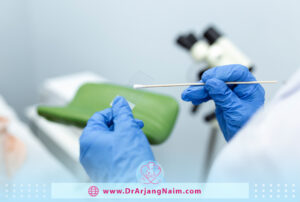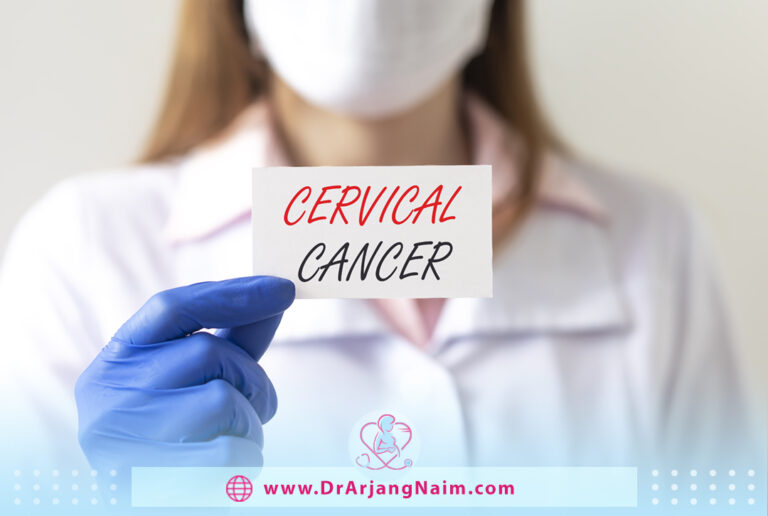Cervical cancer is a type of cancer that occurs in the cells of the cervix, the lower part of the uterus that connects to the vagina. It’s often caused by the human papillomavirus (HPV), a sexually transmitted infection.
Early stages of may not cause any symptoms, but as it progresses, symptoms may include abnormal vaginal bleeding, pelvic pain, pain during sex, and unusual vaginal discharge.
Regular screenings such as Pap smears and HPV tests are essential for early detection. Treatment options depend on the stage of cancer but may include surgery, chemotherapy, radiation, or a combination of these.
The HPV vaccine is also available and recommended for adolescents to protect against several strains of the virus known to cause cervical cancer. Regular screenings and vaccination are crucial preventive measures.
Types of cervical cancer
Cervical cancer is divided into types based on the cell type in which the cancer starts. The main types are:
- Squamous cell cancer. This type of starts in thin, flat cells called squamous cells. Squamous cells cover the outer part of the cervix. Most cervical cancers are squamous cell carcinoma.
- This type of cervical cancer begins in the columnar gland cells that line the cervical canal.
Sometimes, both cell types are involved in cervical cancer. Cancer rarely occurs in other cells of the cervix.

Signs and symptoms
In the early stages, cervical cancer might not present any noticeable signs or symptoms. However, as the cancer progresses, the following signs and symptoms may manifest:
- Abnormal vaginal bleeding: Bleeding between periods, after sexual intercourse, or after menopause can indicate a potential issue.
- Unusual vaginal discharge: An increase in vaginal discharge that may be watery, bloody, or have a foul odor.
- Pelvic pain: Pain in the pelvis or lower back that may occur intermittently or persistently.
- Pain during sex: Discomfort or pain during sexual intercourse.
- Changes in urination or bowel movements: Changes in urination habits, such as increased frequency or difficulty, and bowel movements may occur in advanced stages if the cancer spreads.
Remember, these symptoms can be caused by conditions other than cervical cancer. However, if you experience any of these signs or they persist, it’s crucial to consult a healthcare professional for proper evaluation and diagnosis. Regular screenings and checkups are also essential for early detection and treatment.
You can visit the best OBGYN in Los Angeles, Dr. Arjang Naim, for regular checkups.

Cause
The primary cause of cervical cancer is persistent infection with certain types of the human papillomavirus (HPV). HPV is a very common sexually transmitted infection. However, not all HPV infections lead to cervical cancer; certain high-risk strains, particularly HPV types 16 and 18, are strongly associated with the development of cervical cancer. Factors that increase the risk include:
- HPV infection: Specifically, infection with high-risk strains of HPV.
- Sexual activity: Early initiation of sexual activity, having multiple sexual partners, or having a partner who engages in high-risk sexual behavior can increase the risk of HPV infection.
- Smoking: Women who smoke are at a higher risk of developing.
- Weakened immune system: Individuals with a weakened immune system, such as those with HIV/AIDS or those taking immunosuppressive medications, are at higher risk.
- Family history: A family history might increase the risk.
- Not getting regular Pap tests: Routine screenings help detect abnormal changes in the cervix before they turn cancerous.
Preventive measures such as vaccination against HPV, practicing safe sex, quitting smoking, and regular cervical screenings (Pap tests and HPV tests) can significantly reduce the risk of cervical cancer.

Risk factors
Risk factors include:
- Smoking: Smoking increases the risk of cervical cancer. When HPV infection occurs in people who smoke, the infections last longer and are less likely to clear up.
- Increase in the number of sexual partners: The more the number of sexual partners, the higher the chance of contracting HPV.
- Early sexual activity: Having sex at a young age increases the risk of contracting HPV.
- Other Sexually Transmitted Infections: Having other sexually transmitted infections, also called STIs, increases your risk of getting HPV, which can lead to cervical cancer. Other STDs that increase risk include herpes, chlamydia, gonorrhea, syphilis, and HIV/AIDS.
- Weak immune system: If the immune system is weakened due to another disease and you have HPV, the possibility of cervical cancer may increase.
- Exposure to miscarriage prevention medicine: If a parent takes the drug diethylstilbestrol, also known as DES, during pregnancy, the child’s risk of developing cervical cancer may increase.
Preventing
Preventing involves a combination of vaccination, regular screenings, and healthy lifestyle choices. Here are key preventive measures:
- HPV vaccination: Vaccination against HPV is recommended for both males and females. The HPV vaccine helps protect against the most common high-risk HPV strains that cause cervical cancer. Vaccination is typically recommended for preteens (around age 11–12) before they become sexually active. Still, it can be administered up to age 26 for females and age 21 for males who haven’t been vaccinated earlier.
- Regular screenings: Pap smears (Pap tests) and HPV tests are crucial for early detection of cervical cell changes. Pap tests can identify abnormal cell changes in the cervix before they become cancerous, while HPV tests detect the presence of high-risk HPV strains. These screenings can detect precancerous changes early, allowing for prompt treatment.
- Practice safe sex: Reducing your number of sexual partners and using condoms during sexual activity can lower the risk of HPV transmission, which is a significant cause of cervical cancer.
- Quit smoking: Smoking increases the risk of cervical cancer and can also make treatment less effective. Quitting smoking can significantly decrease this risk.
- Maintain a healthy lifestyle: Eating a balanced diet, maintaining a healthy weight, and regular exercise can contribute to overall health and potentially reduce the risk.
- Regular medical checkups: Regular visits to healthcare providers for routine checkups and discussions about cervical health are essential. They allow timely screenings and the opportunity to discuss any concerns or symptoms.
By combining these preventive measures, individuals can significantly lower their risk of developing cervical cancer and increase the chances of early detection and successful treatment if abnormalities are found.

How is cervical cancer diagnosed?
Cervical cancer develops slowly over many years. Before turning into cancer, cervical cells undergo many changes. Normal cells in the cervix begin to look irregular or abnormal. These abnormal cells may die, remain stationary, or become cancer cells.
Regular women’s screenings with a Pap test can detect most cases of cervical cancer. A Pap smear is a test that collects cells from the cervix. These cells are checked for signs of pre-cancer or other abnormalities. The healthcare provider may also examine the cervix and take a sample of tissue for biopsy if cancer is suspected. If the biopsy confirms cancer, further tests will determine whether the disease has spread (metastasized). These tests may include the following:
- Liver and kidney function studies
- Blood and urine tests.
- X-rays of the bladder, rectum, intestines, and abdominal cavity.
Treatment
Treatment depends on many factors, such as the stage, other health conditions you may have, and your preferences. Surgery, radiation therapy, chemotherapy, or a combination may be used.
Surgery
Small cervical cancers that have not grown beyond the cervix are usually treated with surgery. The size of the cancer, its stage, and whether you want to get pregnant in the future will determine which operation is best for you.
Surgery to remove only the cancer for a very small cervical cancer, it may be possible to remove the entire cancer with a cone biopsy. This procedure involves cutting a cone-shaped piece of cervical tissue and leaving the rest of the cervix intact. This option may make it possible for you to get pregnant in the future.
Surgery to remove the cervix is called a trachelectomy. A small cervical cancer may be treated with a radical tracheotomy. In this method, the cervix and some tissues around it are removed. The uterus remains after this procedure, so you can get pregnant if you want.
Surgery to remove the cervix and uterus is called a hysterectomy. Most cervical cancers that have not spread outside the cervix are treated with a radical hysterectomy. It involves removing the cervix, uterus, part of the vagina, and nearby lymph nodes. A hysterectomy can often cure the cancer and prevent it from coming back. However, removing the uterus makes it impossible to get pregnant.
A minimally invasive hysterectomy may be an option for very small cervical cancers that have not spread, known as microinvasive cancers. This procedure involves making several small incisions in the abdomen instead of one large incision. People with minimally invasive surgery recover faster and spend less time in the hospital. However, some research has shown that minimally invasive hysterectomy may be less effective than traditional hysterectomy. If you are considering minimally invasive surgery, discuss the benefits and risks of this procedure with your surgeon.
Radiation therapy
Radiation therapy uses powerful energy beams to destroy cancer cells. Energy can come from X-rays, protons, or other sources. Radiation therapy is often combined with chemotherapy as the initial treatment for cervical cancers that have grown beyond the cervix. It can also be used after surgery if the risk of cancer recurrence increases.
Chemotherapy
Chemotherapy uses strong drugs to kill cancer cells. For cervical cancer that has spread outside the cervix, low doses of chemotherapy are often combined with radiation therapy. This is because chemotherapy may increase the effects of radiation. Higher doses of chemotherapy may be recommended to help control symptoms of very advanced cancer. Chemotherapy may be used before surgery to shrink the size of the cancer.
Targeted therapy
Targeted therapy uses medicine that attacks specific chemicals in cancer cells. By blocking these chemicals, targeted therapies can cause cancer cells to die. It is usually combined with chemotherapy. It may be an option for advanced cervical cancer.
Immunotherapy
Immunotherapy is a drug treatment that helps the immune system destroy cancer cells. The immune system fights diseases by attacking microbes and other cells that should not be in the body. Cancer cells survive by hiding from the immune system. Immunotherapy helps the cells of the immune system find and destroy cancer cells. For cervical cancer, immunotherapy may be considered when the cancer is advanced, and other treatments have not worked.
The bottom line
Cervical cancer is largely preventable and highly treatable when detected early. Vaccination against HPV, regular screenings (Pap smears and HPV tests), practicing safe sex, and leading a healthy lifestyle significantly reduce the risk. Early detection through screenings allows for timely intervention, improving the chances of successful treatment. Awareness, education, and access to healthcare play pivotal roles in preventing and managing cervical cancer effectively.
Additional questions
- What is the survival rate of cervical cancer?
In people with cervical cancer diagnosed at an early stage, the five-year relative survival rate is more than 90%. Almost half of cervical cancers are diagnosed in the early stages. If the cancer has spread to other tissues or organs, the five-year survival rate is 58%.
- Will cervical cancer treatment affect sex life?
Certainly! treatments like chemotherapy, radiation, or surgery can potentially impact one’s sex life. These treatments might lead to changes in libido due to fatigue or hormonal shifts. Surgeries, such as a hysterectomy, could alter physical sensations during intercourse, while radiation therapy might cause vaginal dryness or narrowing.
- What are five sexually transmitted infections?
- Syphilis
- Chlamydia
- Gonorrhea
- Human Papillomavirus
- Hepatitis
- At what stage can cervical cancer be treated?
In some cases, it may have gone into the uterus but not progressed outside it. It has not spread to lymph nodes or distant sites. In general, cervical cancer that is detected and treated in the early stages is highly curable.
- What to eat to reduce the risk of cervical cancer?
Most cervical cancer is caused by infection with a common sexually transmitted virus called human papillomavirus (HPV). It is usually harmless, although in some cases, it can cause cervical cancer. A study found that if a woman is infected with HPV, eating one or more servings of certain vegetables a day can help her body eliminate the virus. The studied vegetables include:
- Sweet potatoes
- Spinach
- Kale and other greens
- Papaya
- Oranges
- Sweet peppers
- Tomatoes
References
https://www.cancer.org.au/cancer-information/types-of-cancer/cervical-cancer
https://www.mayoclinic.org/diseases-conditions/cervical-cancer/diagnosis-treatment/drc-20352506
https://www.cancer.org/cancer/types/cervical-cancer/about/what-is-cervical-cancer.html
https://www.nhs.uk/conditions/cervical-cancer/causes/
https://my.clevelandclinic.org/health/diseases/12216-cervical-cancer
https://www.healthline.com/health/cervical-cancer#symptoms




